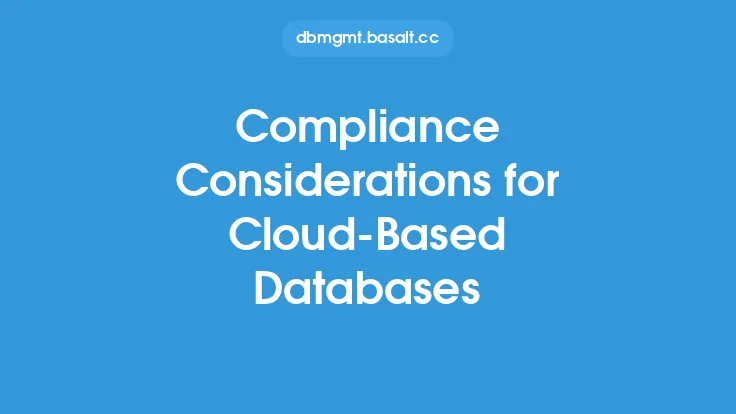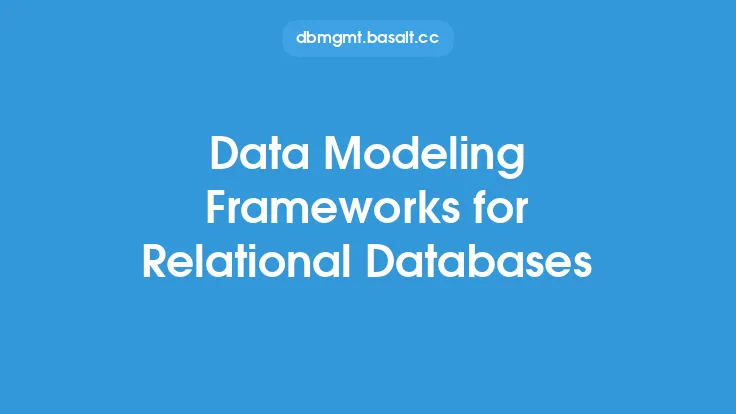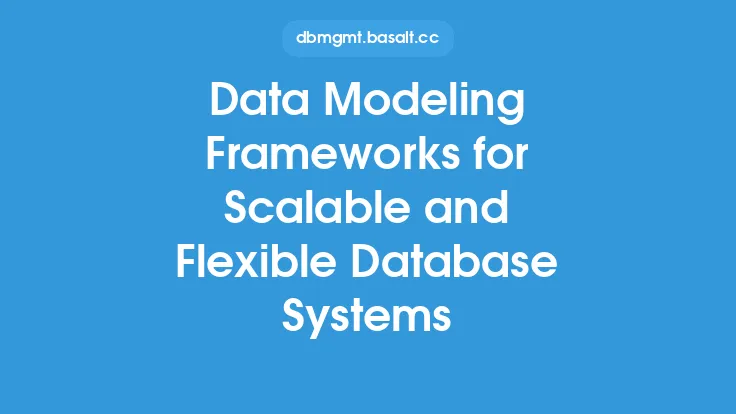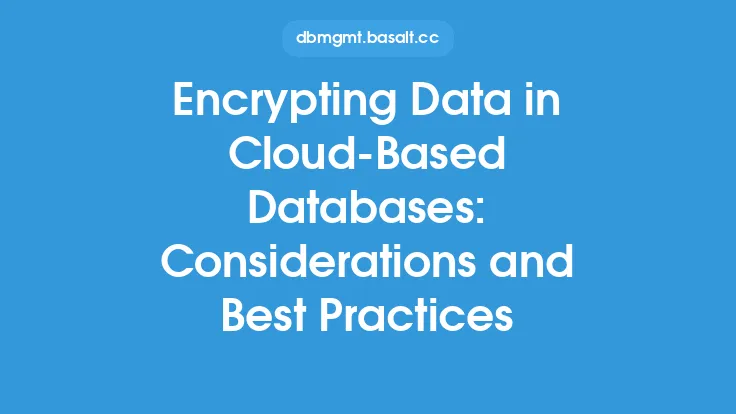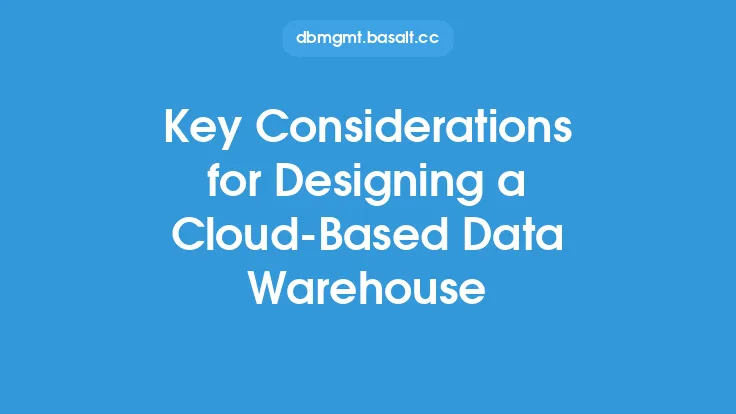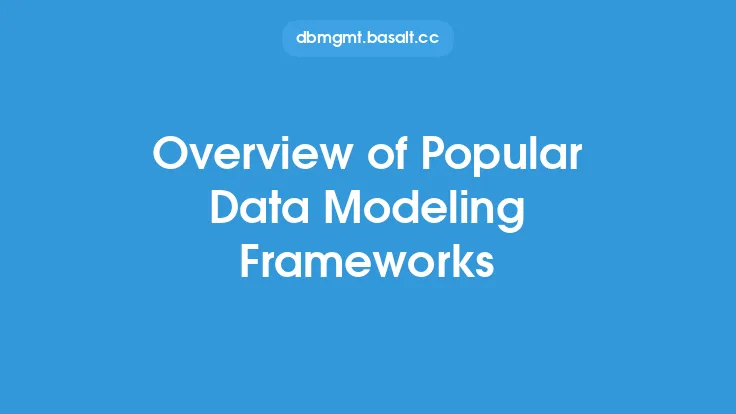Data modeling frameworks play a crucial role in designing and implementing cloud-based databases, as they provide a structured approach to defining the relationships between different data entities and organizing data in a way that supports scalability, flexibility, and performance. Cloud-based databases offer a unique set of challenges and opportunities, and data modeling frameworks must be adapted to take advantage of the cloud's capabilities while mitigating its limitations.
Key Considerations for Cloud-Based Data Modeling Frameworks
When designing a data modeling framework for a cloud-based database, there are several key considerations that must be taken into account. First and foremost, the framework must be able to handle the scalability and elasticity of the cloud, which can lead to rapid changes in data volume and velocity. This requires a framework that is flexible and adaptable, able to adjust to changing data patterns and workflows. Additionally, the framework must be able to handle the distributed nature of cloud-based data, which can be spread across multiple servers and locations.
Another important consideration is data security and governance, as cloud-based data is often subject to a wide range of regulatory and compliance requirements. The data modeling framework must be able to ensure that data is properly encrypted, access-controlled, and audited, while also providing a clear and transparent understanding of data lineage and provenance. Finally, the framework must be able to integrate with a wide range of cloud-based services and tools, including data warehousing, business intelligence, and machine learning platforms.
Cloud-Based Data Modeling Framework Components
A cloud-based data modeling framework typically consists of several key components, including data entity definition, relationship definition, data governance, and data integration. Data entity definition involves defining the structure and attributes of each data entity, including tables, columns, and data types. Relationship definition involves defining the relationships between different data entities, including foreign keys, joins, and data flows.
Data governance involves defining the rules and policies that govern data access, security, and quality, including data encryption, access control, and data validation. Data integration involves defining the interfaces and APIs that connect the data model to other cloud-based services and tools, including data warehousing, business intelligence, and machine learning platforms. Additionally, the framework may include components for data transformation, data aggregation, and data visualization, as well as tools for data quality, data profiling, and data lineage.
Data Modeling Frameworks for Cloud-Based NoSQL Databases
NoSQL databases are particularly well-suited to cloud-based environments, as they offer a flexible and scalable approach to data storage and retrieval. Data modeling frameworks for NoSQL databases must be able to handle the unique characteristics of NoSQL data, including flexible schema, document-oriented data, and graph-based data. Some popular data modeling frameworks for NoSQL databases include MongoDB's data modeling framework, Cassandra's data modeling framework, and Amazon's DynamoDB data modeling framework.
These frameworks provide a range of tools and techniques for defining data entities, relationships, and governance, as well as integrating with other cloud-based services and tools. For example, MongoDB's data modeling framework provides a range of features for defining document-oriented data, including schema design, data validation, and data aggregation. Cassandra's data modeling framework provides a range of features for defining distributed data, including data partitioning, data replication, and data consistency.
Data Modeling Frameworks for Cloud-Based Relational Databases
Relational databases are also widely used in cloud-based environments, and data modeling frameworks for relational databases must be able to handle the unique characteristics of relational data, including fixed schema, table-oriented data, and SQL-based querying. Some popular data modeling frameworks for relational databases include Amazon's Aurora data modeling framework, Google's Cloud SQL data modeling framework, and Microsoft's Azure SQL Database data modeling framework.
These frameworks provide a range of tools and techniques for defining data entities, relationships, and governance, as well as integrating with other cloud-based services and tools. For example, Amazon's Aurora data modeling framework provides a range of features for defining relational data, including schema design, data validation, and data querying. Google's Cloud SQL data modeling framework provides a range of features for defining relational data, including data migration, data replication, and data security.
Best Practices for Implementing Cloud-Based Data Modeling Frameworks
Implementing a cloud-based data modeling framework requires a range of best practices, including defining clear data governance policies, establishing data quality and validation procedures, and implementing data security and access controls. Additionally, the framework should be designed to be flexible and adaptable, able to adjust to changing data patterns and workflows.
The framework should also be designed to integrate with a wide range of cloud-based services and tools, including data warehousing, business intelligence, and machine learning platforms. Finally, the framework should be designed to provide clear and transparent visibility into data lineage and provenance, including data origin, data transformation, and data aggregation. By following these best practices, organizations can ensure that their cloud-based data modeling framework is able to support their business goals and objectives, while also providing a scalable, flexible, and secure approach to data management.
